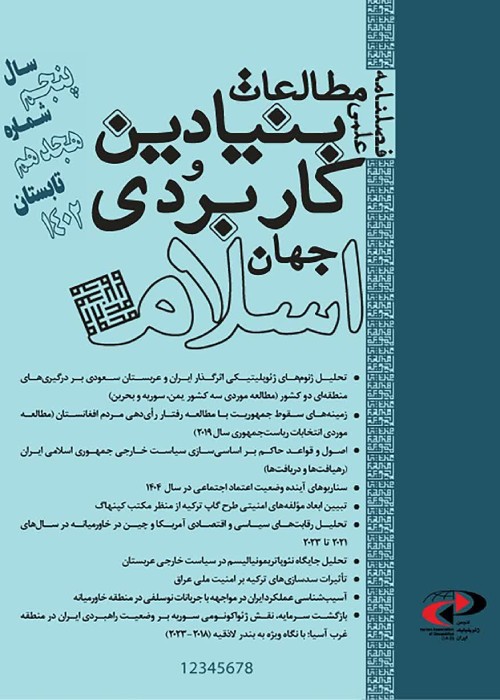Analysis of Iranian Science and Technology Diplomacy toward Islamic Countries of Southeast Asia
In today's world, education is the fourth dimension of foreign policy. Educational cooperation is a kind of investment for the future of diplomatic relations among nations. Since the most political elites are selected from academia, the expansion of international scholarships and the admission of international students are two ways of introduction of their cultures and communities to the future political leaders and the senior executives around the world. Academic relations can also develop political and economic relations between the governments. It is argued that from an economic point of view, science and technology diplomacy can save countries’ national economies, because, first, it accelerates countries’ scientific development; second, it creates a wealth of economic experience and connections, and third, it expands trade, industry, science, and national gross income as an economic resource. From a cultural point of view, the most important function of science and technology diplomacy is to spread and export the values, principles, norms, and meanings of the national culture of countries to the international arena. One of the pillars of the foreign policy of the Islamic Republic of Iran since the ninth government onward has been to expand the relations with Asian countries in the form of Look East Policy. This article tries to analyze and evaluate a part of Look East Policy, namely science and technology diplomacy of the Islamic Republic of Iran toward the countries of the Southeast Asia region, especially the Islamic countries of this region. On this basis, we first address the issue of what is science and technology diplomacy and what are its components, features, and dimensions. Secondly, what are the goals and manifestations of this type of diplomacy? Third, what is the place of science and technology diplomacy in the Look East Policy of the Islamic Republic of Iran, and finally, how is Iran's science and technology diplomacy evaluated in relation to the Islamic countries of Southeast Asia, namely Malaysia and Indonesia?
If we want to study the science and technology diplomacy of the Islamic Republic of Iran toward the Islamic countries of Southeast Asia, namely Indonesia, Malaysia and Brunei, this study has to be done based on documented data. Unfortunately, there was no data on the country of Brunei in the research process, and therefore, this country was removed from the list of countries which were surveyed. There were also scattered data on scientific and technological cooperation of Iran on the one hand and Malaysia and Indonesia on the other hand, based on which the data of this topic has been adjusted. However, the science and technology diplomacy of the Islamic Republic of Iran toward the Islamic countries of Southeast Asia is significant in some indicators, including joint scientific productions with researchers from Malaysia, the establishment of a Persian language department at Putra University Malaysia and the conclusion of memorandums and academic agreements, but in some respects it still needs further strengthening. It seems that before addressing other indicators of the science and technology diplomacy of the Islamic Republic of Iran toward the Islamic countries of Southeast Asia, the issue of reviewing the Look East Policy should be on the agenda of the country's policymakers. Accordingly, the Look East Policy should move away from the initial reactionary and reflective status and become a strategic and long-term plan of Iran's foreign policy. The Islamic Republic of Iran can easily expand its cooperation with the mentioned countries in various fields, including science and technology, by belonging to the civilization of the Orient and having some cultural and religious commonalities and historical relations with the inhabitants of the Southeast Asian countries. Therefore, it must take a strategic and long-term approach to the great society of the East and devise a suitable strategy to make optimal use of the maximum capacity of Asian countries and promote its national interests.
In this regard, due to some cultural and religious commonalities, and historical relations with the countries of Southeast Asia, it is possible to come up with proposals focusing on different dimensions of diplomacy, which can be viewed as strategies for expanding science and technology diplomacy under the Look East Policy:• Holding joint scientific conferences and meetings in various areas;
• Identifying the scientific capabilities of the Islamic countries of the region and trying to strengthen relations in those fields;
• Compilation of a science and technology diplomacy document and determining the position of Islamic countries in the Southeast Asian region;
• Making efforts at further expansion of the exchange of professors and students between the Islamic Republic of Iran and the Islamic countries of the region;
• Promoting cooperation of national scientific and technological institutions with their counterparts in the Islamic countries of the region;
• Establishig Persian language departments in Malaysian and Indonesian universities;
• Using the capacity of regional institutions and organizations to expand scientific and technological relations;
• Holding training courses for Iranian ambassadors and diplomats in the countries of the region to get acquainted with science and technology diplomacy as well as the scientific developments in the country of mission.
- حق عضویت دریافتی صرف حمایت از نشریات عضو و نگهداری، تکمیل و توسعه مگیران میشود.
- پرداخت حق اشتراک و دانلود مقالات اجازه بازنشر آن در سایر رسانههای چاپی و دیجیتال را به کاربر نمیدهد.


